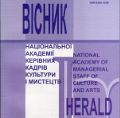МЕТАМОРФОЗИ КАМЕРНО-ВОКАЛЬНОГО ЦИКЛУ У ТВОРЧОСТІ М. ШУХА (НА ПРИКЛАДІ МЕДИТАТИВНОГО ДІЙСТВА «ПІСНІ ВЕСНИ»)
METAMORPHOSIS OF CHAMBER-VOCAL CYCLE IN THE WORK OF M. SHUKH (ON THE EXAMPLE OF THE MEDITATIVE PERFORMANCE "SONGS OF SPRING")
Author(s): Larisa GorelikSubject(s): Music
Published by: Національна академія керівних кадрів культури і мистецтв
Keywords: "Spring Songs" by M. Shukha; "meditative action"; chamber-vocal cycle; culture of the East and the West; postmodernism;
Summary/Abstract: The purpose of the research is to identify the poetic and intonation uniqueness of M. Shuh's "Songs of Spring" in the context of the evolutionary paths of the development of the chamber-vocal cycle in the 20th century. The methodological basis of the work is the intonation approach in musicology, as well as the historical-cultural and interdisciplinary approach, which allow to investigate the peculiarities of the evolution of the chamber-vocal cycle in postmodern culture, in particular, in "Songs of Spring" by M. Shukh. The scientific novelty of the work is due to its analytical perspective, which takes into account not only the specifics of the existence of the vocal cycle in the culture of late 20th century, but also the peculiarities of their reproduction in the "Songs of Spring", defined by the author as a "meditative action" formed at the intersection of the cultural and historical traditions of the East and the West. Conclusions. The vocal-instrumental cycle "Songs of Spring" by M. Shukh, the genre of which the composer himself defined as "meditative action", combined the spiritual teachings of Eastern and Western cultures. The first is evident in the poetic basis of the work, which appeals to ancient Chinese poetry and its oriental images-symbols ("jasper flute"), while the Western tradition is revealed in the post-modern metamorphoses of the poetics of the chamber-vocal cycle, which in this case converges with a mysterious and meditative spectacle. The marked genre synthesis of M. Shukh's cycle also determines the author's innovative approach to his performance composition, which combines a solo soprano, flute, and a number of percussion instruments into a polyphonic whole, the timbre of which reproduces the oriental (Chinese) flavour of this opus (tam-tam, bells, triangle, bongo, vibraphone, and others). This timbre-polyphonic ensemble is also complemented by the part of the chant, which clearly speaks a significant part of the poetic text. The leading idea of the work, which has a single pentatonic intonation basis, turns out to be ultimately focused also on the idea of the inner spiritual transformation of a person through the contemplation of spring and its signs, filled with deep symbolic meaning.
Journal: Вісник Національної академії керівних кадрів культури і мистецтв
- Issue Year: 2023
- Issue No: 3
- Page Range: 199-205
- Page Count: 7
- Language: Ukrainian

